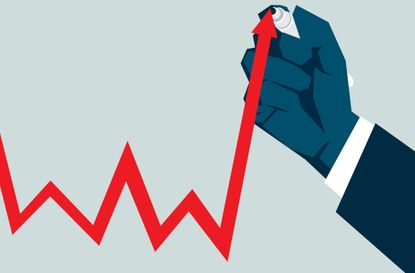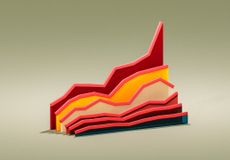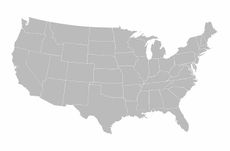Kiplinger Inflation Outlook: A Glass Half Full
Inflation will decline further, but price pressures remain.
- (opens in new tab)
- (opens in new tab)
- (opens in new tab)
- Newsletter sign up Newsletter


Kiplinger’s Economic Outlooks are written by the staff of our weekly Kiplinger Letter and are unavailable elsewhere. Click here for a free issue of The Kiplinger Letter or for more information.
There was something for both inflation optimists and pessimists in the March consumer price index (CPI) report.
For optimists: Annual inflation dropped to 5.0% in March, and will likely drop below 4% by the end of the year. Shelter prices, the biggest single component in the index, slowed their rate of increase to 0.6%, from 0.8% the previous month, and are expected to slow further. The prices of other services slowed their rate of increase a tick, to 0.4%. The price of groceries declined modestly, their first price drop in almost three years. Meat prices edged down, and egg prices have fallen 17% over the past two months. Energy prices dropped 3.5%, with the biggest decline in natural gas. The recent surge in clothing prices eased, and goods prices in general showed only a modest increase. Used car and truck prices declined for the ninth consecutive month. The large jumps in airfares and hotel rates in March are part of the normal rebound in these prices after the pandemic, and so aren’t likely to be sustained.

Sign up for Kiplinger’s Free E-Newsletters
Profit and prosper with the best of expert advice on investing, taxes, retirement, personal finance and more - straight to your e-mail.
Profit and prosper with the best of expert advice - straight to your e-mail.
For pessimists: The big drop in annual inflation was mostly due to the energy price spike of March 2022 dropping out of the calculation. (A further big drop in the energy component of inflation will likely happen in June, but again, only because of similar price jumps of a year ago that will fall out of the year-over-year calculation.) Price increases in services remain stubbornly high, as wage gains that drive up businesses’ operating costs are proving slow to moderate. This is likely the reason why price increases at restaurants have not slowed, for example. Excluding food and energy, so-called core inflation is still at 5.6% and may stay above 5% for the rest of the year. Price increases of new vehicles strengthened in March, and we expect prices of used vehicles to also jump in April. Gasoline prices are increasing in April because of oil production cuts by OPEC.
The “glass half full” report likely means that the Federal Reserve will raise its short-term interest rates by a quarter of a percentage point again on May 3, but pause after that. The persistence of inflation in the services sector will likely keep the Fed from cutting rates this year unless a recession hits.
The Fed is looking for easing in the underlying components of inflation that create month-to-month momentum. Shelter is important, too, since it’s a large part of the index, but Chair Powell has stated that he knows that slowdowns in this component “are in the pipeline,” as rental agreements come up for renewal and landlords dial back rent increases. But the Fed is concerned that if inflation comes down too slowly, then wage increases will stay strong, creating a cycle of further price increases, as businesses try to maintain their profit margins by passing higher wage costs along to customers.
Related content
- Kiplinger's Economic Outlooks
- When is the next Fed meeting
- How inflation can impact your taxes
- Is inflation costing you more as a retiree?

-
-
 IRS Service Improvements Could Bring Faster Tax Refunds
IRS Service Improvements Could Bring Faster Tax RefundsRecent IRS improvements mean taxpayers could see faster tax refunds next year and beyond.
By Katelyn Washington • Published
-
 For Best Tax Savings, Year-Round Tax Planning Is Essential
For Best Tax Savings, Year-Round Tax Planning Is EssentialFor optimal, ongoing tax reduction, consider employing these nine strategies throughout the entire year.
By Andy Leung, Private Wealth Adviser • Published
-
 Kiplinger's Retail Outlook: Consumers Are Still Resilient
Kiplinger's Retail Outlook: Consumers Are Still ResilientEconomic Forecasts Kiplinger's Retail Outlook: Sales this year are likely to be mostly stable, even as the economy slows.
By David Payne • Last updated
-
 Kiplinger's Trade Outlook: Trade Deficit Wider, Thanks to Weaker Exports and Imports
Kiplinger's Trade Outlook: Trade Deficit Wider, Thanks to Weaker Exports and ImportsEconomic Forecasts February export losses undo most of January’s gains.
By Rodrigo Sermeño • Last updated
-
 Business Cost Outlooks for 2022: Eight Key Sectors
Business Cost Outlooks for 2022: Eight Key SectorsEconomic Forecasts What’s in store for all sorts of business costs in 2022?
By The Kiplinger Washington Editors • Published
-
 Our "K-Shaped," Uneven Economic Recovery
Our "K-Shaped," Uneven Economic RecoveryEconomic Forecasts Confidence is key to the recovery, but the sentiment depends on consumers’ financial circumstances.
By Sandra Block • Published
-
 7 Ways the Pandemic Will Change Big U.S. Cities
7 Ways the Pandemic Will Change Big U.S. CitiesEconomic Forecasts Historically, pandemics transform cities.
By Matthew Housiaux • Published
-
 What Do Negative Oil Prices Mean?
What Do Negative Oil Prices Mean?Economic Forecasts With oil prices having dipped into negative territory, S&P Global Platts's Vito Turitto joins our hosts Sandy Block and Ryan Ermey to break down exactly what's going on. Also, the cohosts give an update on stimulus checks.
By Sandra Block • Published
-
 Is Your State Prepared for a Recession?
Is Your State Prepared for a Recession?Economic Forecasts The Kiplinger Letter's managing editor Jim Patterson joins our hosts Ryan Ermey and Sandy Block to break down the ramifications for states that aren't equipped to handle the upcoming recession. The pair also discusses bear market investing strategies.
By Sandra Block • Published
-
 PPP Program Is Out of Funds — But Firms Should Keep Applying
PPP Program Is Out of Funds — But Firms Should Keep Applyingbusiness There’s a reason the money’s all gone — the terms of the Paycheck Protection Program for small businesses are generous.
By Rodrigo Sermeño • Last updated









